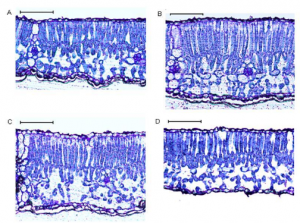DOI: 10.2135/cropsci2016.02.0122
Genetic and physiological diversity in the leaf photosynthetic capacity of soybean
Abstract
 Enhancement of leaf photosynthetic capacity can lead to greater biomass productivity in crop plants. Targets for improving leaf photosynthetic capacity in soybean [Glycine max (L.) Merr.], however, remain to be elucidated. The objective of this study was to identify the physiological and morphological factors underlying the diverse photosynthetic capacities of different soybean genotypes. Light-saturated CO2 assimilation rates ranged from 18.1 to 27.6 μmol m−2 s−1 under controlled conditions among 34 genotypes. PI 594409 A (Line no. 13) and PI 603911 C (Line no. 14) showed extremely high photosynthetic rates. Line no. 14 consistently showed greater photosynthetic rates than other lines under field conditions and reached 34.8 μmol m−2 s−1, which was 11% greater than that of a reference genotype, Tachinagaha. The analysis of the CO2 response curve of Line no. 14 showed greater CO2 fixation activity, represented by the maximum rates of carboxylation (Vcmax) and electron transport (Jmax). The leaf ribulose-1,5-bisphosphate carboxylase/oxygenase (Rubisco) content of Line no. 14 tended to be higher than that of other lines, which is suggested to contribute to high CO2fixation activity. We attribute the high photosynthetic capacity that was observed among soybean genotypes to high CO2 fixation activity.
Enhancement of leaf photosynthetic capacity can lead to greater biomass productivity in crop plants. Targets for improving leaf photosynthetic capacity in soybean [Glycine max (L.) Merr.], however, remain to be elucidated. The objective of this study was to identify the physiological and morphological factors underlying the diverse photosynthetic capacities of different soybean genotypes. Light-saturated CO2 assimilation rates ranged from 18.1 to 27.6 μmol m−2 s−1 under controlled conditions among 34 genotypes. PI 594409 A (Line no. 13) and PI 603911 C (Line no. 14) showed extremely high photosynthetic rates. Line no. 14 consistently showed greater photosynthetic rates than other lines under field conditions and reached 34.8 μmol m−2 s−1, which was 11% greater than that of a reference genotype, Tachinagaha. The analysis of the CO2 response curve of Line no. 14 showed greater CO2 fixation activity, represented by the maximum rates of carboxylation (Vcmax) and electron transport (Jmax). The leaf ribulose-1,5-bisphosphate carboxylase/oxygenase (Rubisco) content of Line no. 14 tended to be higher than that of other lines, which is suggested to contribute to high CO2fixation activity. We attribute the high photosynthetic capacity that was observed among soybean genotypes to high CO2 fixation activity.
